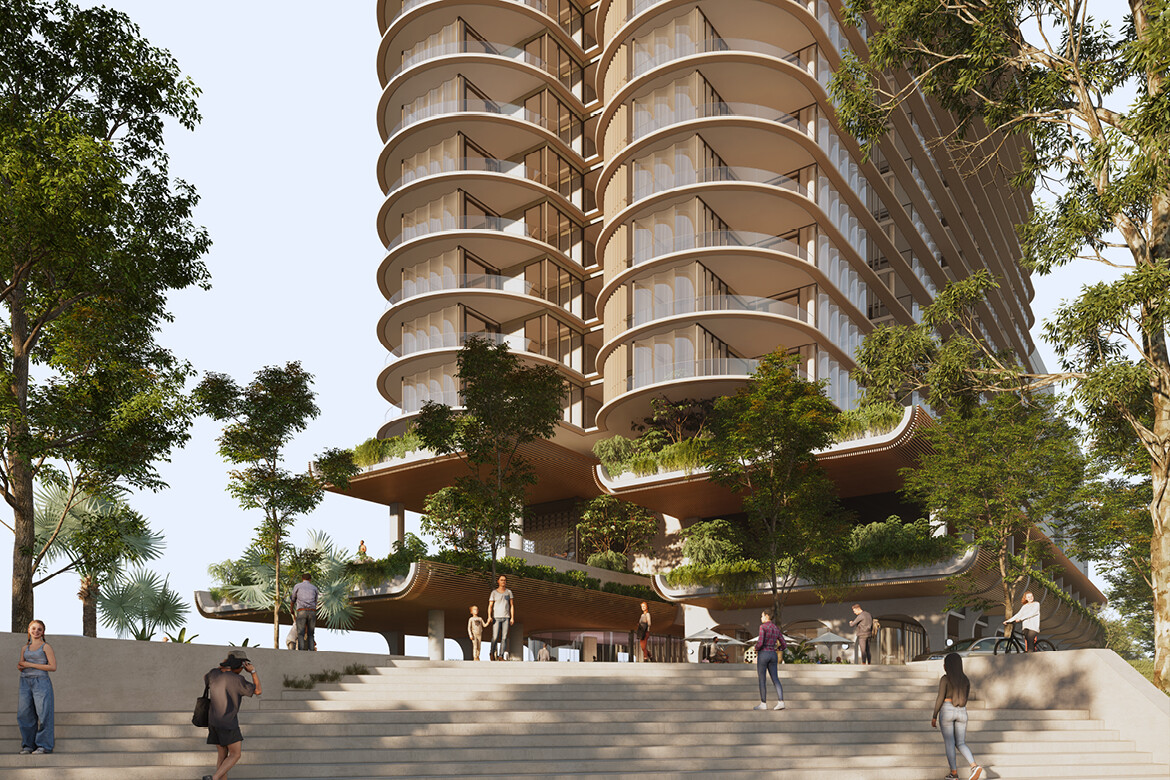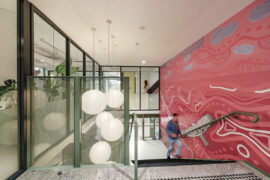The build-to-rent model stands out as one of the most prominent discussions in design and development circles, so we’ve engaged with various perspectives and case studies from industry leaders and shifters. From citymaking design practices to entrepreneurial viewpoints, these stories provide a nuanced understanding of this increasingly prevalent model.

May 9th, 2024
As the build-to-rent sector gains traction globally, these varied perspectives highlight the nuanced complexity of this housing model. It holds promise in designing positive, inclusive urban environments that meet the contemporary and changing of residents, both today and for generations to come. Here’s what industry leaders have had to say on the matter and how they are effectively driving change.
Hassell’s Perth build-to-rent housing commended by Prime Minister
Hassell’s pioneering 29-storey development on the outskirts of Perth’s CBD, paying homage to the city’s illustrious printing heritage, serves as a noteworthy case study. Integrating design motifs inspired by traditional printing techniques, the project addresses the pressing issue of housing affordability plaguing Australian urban landscapes. Prime Minister Anthony Albanese lauded the development and its potential to deliver over 200 well-positioned homes for Western Australians, marking a significant stride in addressing housing needs while breathing new life into Perth’s north-eastern CBD.
“This project ticks all the boxes and will deliver more than 200 new well-located homes for Western Australians,” said Australian Prime Minister Anthony Albanese as he announced the news.

SJB explores the value proposition of build-to-rent
In this comment piece, SJB director Nigel Morris discusses a test case for amenity-driven living in the build-to-rent sector, as an in-demand rental solution for young urban professionals who are unable to break into property ownership but have a medium-to-high income and want to live in a great area in premium accommodation with amenities. Morris delineates how amenity-rich environments cater to the preferences of discerning urban professionals seeking premium accommodation in prime lotions. SJB first investigated the model back in 2019 and by mid-2022, completed one of Australia’s first BTR projects incorporating 368 dwellings.

Bates Smart and the build-to-rent model for city living
The unveiling of LIV Munro in Melbourne is testament to Bates Smart’s design prowess and epitomises that building for renting will meet needs and offer a lifestyle filled with amenity and facility. With a steadfast commitment to environmental stewardship and resident-centric design, LIV Munro offers a proposition for long-term renters, eschewing traditional bonds in favour of fostering a sense of ownership and belonging. With the challenges that are presented to architects and designers these days, one thing is certain: Bates Smart has captured the place and time and designed an exemplar building that not only meets requirement but totally exceeds it.

Rory Hunter envisages a one man’s MODEL for build-to-rent
Entrepreneur Rory Hunter envisions a model of build-to-rent that prioritises residents’ well-being and community integration. Through his initiative, MODEL, Hunter advocates for a paradigm shift in design, construction and living arrangements, with a focus on secure, amenity-rich environments tailored to contemporary needs. With impending climate challenges and demographic shifts on the horizon, Hunter’s vision serves as a beacon of hope, heralding a transition towards tenant-centric, sustainable living solutions.
“Australia’s current approach to housing is untenable, especially given impending climate challenges and population growth. I hope that MODEL serves as a lighthouse for tenant-centric, amenity-rich living, pointing the way toward a post-carbon future,” says Rory Hunter.

‘Sticky tenants’ with Make Architects: UK learnings for Australian build-to-rent
Frank Filskow, leading the build-to-rent team at Make Architects, draws parallels between the UK and Australian build-to-rent landscapes, to emphasise the importance of cultivating enduring tenant relationships. With Australia’s build-to-rent sector is rapidly expanding, Filskow leverages insights gleaned from Make’s extensive experience in both markets and questions what can Australian build-to-rent developers learn from the experienced UK market and how can these lessons be applied locally?
“With the asset class still in its infancy, developers are keen to understand where the opportunities lie and align their products with local preferences and market conditions. Regardless of location, the hidden value lies in long-term, ‘sticky tenants’,” declares Filskow.

Susanne Pini on build-to-rent, the new place activator
In a thought-provoking dialogue, Rothelowman principal Susanne Pini champions the build-to-rent model as a catalyst for fostering inclusive urban spaces. Pini challenges the prevailing notion of ‘activation’ solely through retail, advocating instead for a holistic approach that prioritises community engagement and social interaction. “In the right place, in the right quantum, with the right metrics, retail is an amazing activator. However, when we see it as the only way to activate or create place, we achieve the exact opposite,” says Pini.
In contrast, the build-to-rent model can give rise and reason to why you would value stopping and lingering a bit longer in spaces filled with your community and contends that these projects have the potential to nurture authentic, enduring connections within burgeoning urban landscapes.

In 2032 Brisbane will host the world’s first climate-positive games and Brisbane-based urban designer and landscape architect Ben Newell outlines four key strategies for realising a sustainable, legacy-driven vision for the city’s upcoming endeavour. Emancipating the creative professionals as responsible for shaping our cities and buildings, and the public spaces that connect them, in a way that prioritises the people who use them. In this conversation, Newell touches on the importance of understanding locals’ likes & dislikes, designing for easy access to popular places, convenient and comfortable, transport links and deploying design to achieve sustainability.

Next up: 8 thought-provoking stories about housing and its multiple crises
INDESIGN is on instagram
Follow @indesignlive
A searchable and comprehensive guide for specifying leading products and their suppliers
Keep up to date with the latest and greatest from our industry BFF's!

Sydney’s newest design concept store, HOW WE LIVE, explores the overlap between home and workplace – with a Surry Hills pop-up from Friday 28th November.

In an industry where design intent is often diluted by value management and procurement pressures, Klaro Industrial Design positions manufacturing as a creative ally – allowing commercial interior designers to deliver unique pieces aligned to the project’s original vision.

CBRE’s new Sydney workplace elevates the working life and celebrates design that is all style and sophistication.

From radical material reuse to office-to-school transformations, these five projects show how circular thinking is reshaping architecture, interiors and community spaces.
The internet never sleeps! Here's the stuff you might have missed

From furniture and homewares to lighting, Dirk du Toit’s Melbourne-based studio Dutoit is built on local manufacturing, material restraint and the belief that longevity is central to sustainable design.

In an industry where design intent is often diluted by value management and procurement pressures, Klaro Industrial Design positions manufacturing as a creative ally – allowing commercial interior designers to deliver unique pieces aligned to the project’s original vision.